Ye-152M
By the late 1950s the Mikoyan OKB had moved on to envisage this as the ultimate single-engined heavy interceptor. It was to have the R-15B-300 engine, with a maximum rating of 10,210kg (22,509 Ib) and an improved propulsive nozzle of convergent/divergent form, considerably greater internal fuel capacity in an added fuselage spine, wingtip rails for the Volkov K-80 missile (later produced as the R-4R and R-4T), and many other modifications including canard foreplanes which this time were to be fully powered. The Ye-152/2 was rebuilt into the Ye-152P (from Perekhvatchik, interceptor) as a stepping stone to the Ye-152M. Externally it incorporated all the new features, including the roots for the foreplanes, but the surfaces themselves were not fitted. By the time the rebuild was complete the IA-PVO (manned fighter branch of the air defence forces) had selected the Tupolev Tu-128, and Mikoyan was well ahead with the far more impressive twin-engined MiG-25. In 1965 the Ye-152P, with the missile launchers replaced by more pointed wing – tips, was put on display as the ‘Ye-166’, adorned with the details of the records set by the Ye-152/1. It still survives at the Monino museum in Moscow.

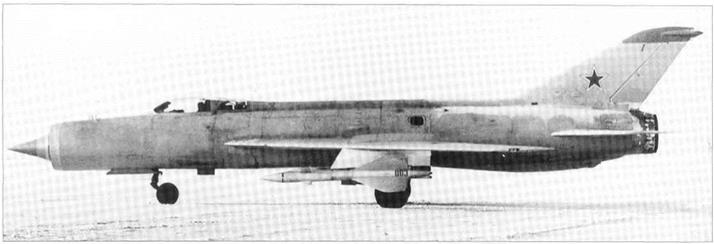
Top left: I-3U.
Top right: I-7U.
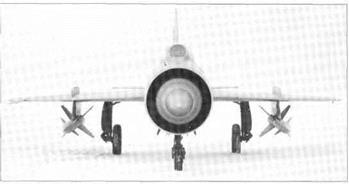 Above and right: Two views of I-75. Bottom: Ye-150.
Above and right: Two views of I-75. Bottom: Ye-150.
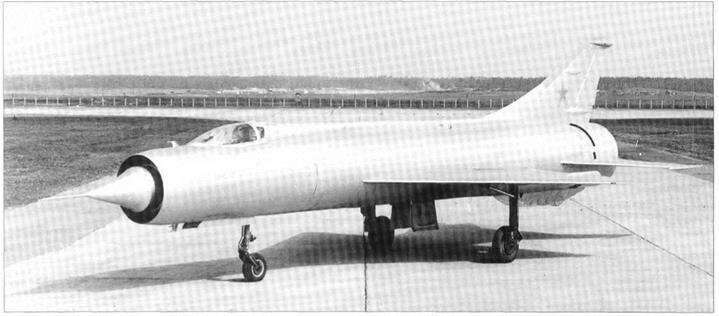
|
|
|
 |
|
|
|
|
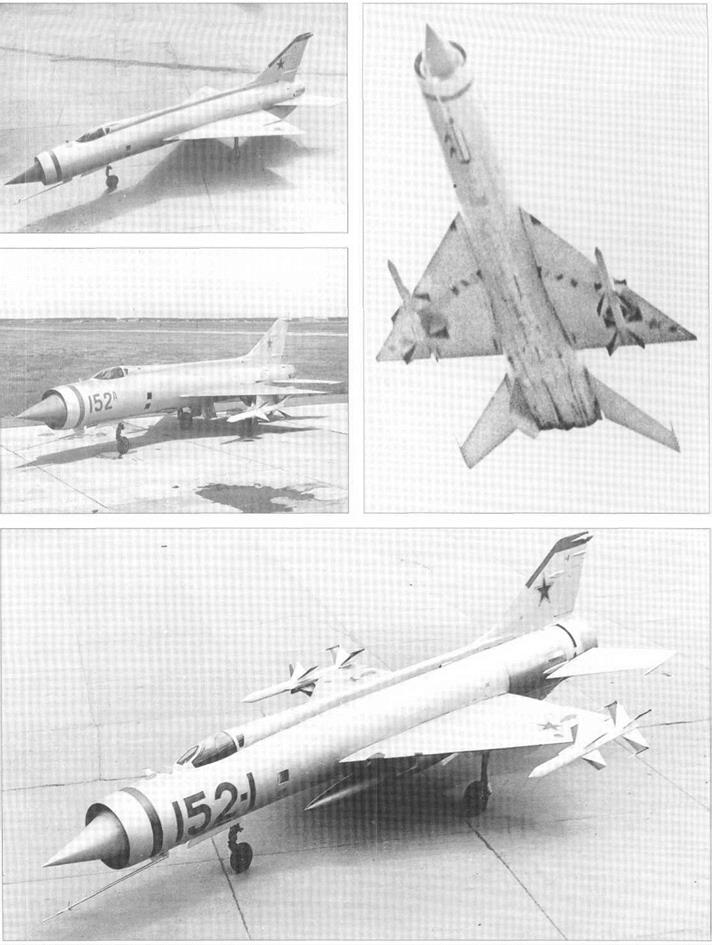
![]()
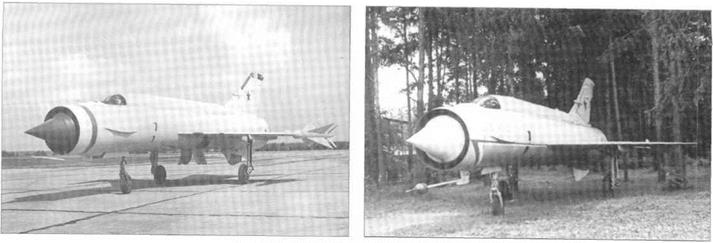
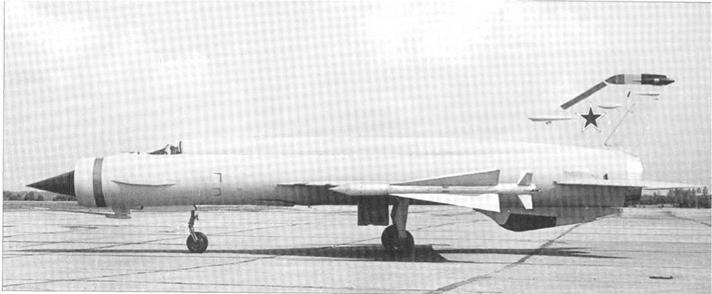
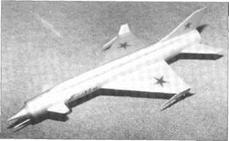
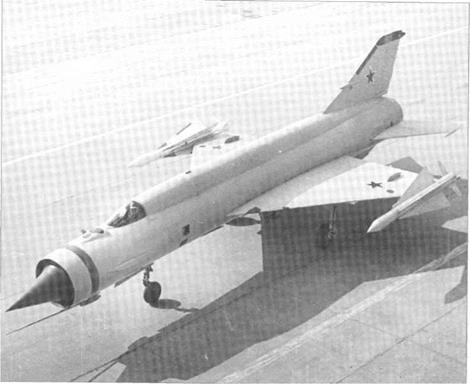
Photographs on the opposite page:
Top left: e-l52A.
Top right: Ye-152A with K-9-155 mis siles.
Centre: Ye-152A with K-9-155 missiles.
Bottom: Ye-152/1 with K-9-155 missiles.
Photographs on this page:
Above: Ye-152M project model.
Top left, centre and bottom right: Ye-152M with K-80 missile mock-ups.
Top right: Ye-152M record version (so-called ’Ye-166′) at Monino.
 Ye-2, Ye-4, Ye-5
Ye-2, Ye-4, Ye-5
The Korean War of 1950-53 triggered a significant acceleration of development of weapons in the Soviet Union. For the first time the ‘MiG’ OKB found itself working under intense pressure on two distinct classes offighter. The first to be launched were the big radar-equipped interceptors typified by a wing area of 30m2 (323ft2) and engines in the thrust range 9,072 to 13,608kg (20,000 to 30,000 Ib). The second family were small but agile fighters intended for close visual combat, characterised by wings of some 22m2 (237ft2) and engines in the 5,000kg (ll,0201b) class. The smaller aircraft were required to reach Mach 2 on the level at heights up to 20km (65,617ft) whilst carrying guns and a radar-ranging sight. Intensive tunnel testing failed to show clear superiority between a swept wing rather like a small version of that of the MiG-19, with a leading – edge sweep of 61°, and the new delta (triangular) shape with a leading-edge angle of 57°, so it was decided to build experimental versions of both. The single engine was Tuman – skii’s AM-9B (later called RD-9B), as used in the twin-engined MiG-19, with a maximum afterburning thrust of3,250kg (7,165 Ib). The following specification refers to the swept-wing Ye-2, first flown on 14th February 1955. This led to the mixed-power Ye-50. The Ye-4, the first of the deltas, was very similar but had a disappointing performance. Despite this, with minor changes the delta Ye-5 was some 700km/h faster, leading to the production MiG-21. Even though all versions had limited capability, this small fighter was produced in four countries in greater numbers than any other military aircraft since 1945 apart from the MiG-15. Assuming 2,400 for Chinese production the total was 13,409.
|
Dimensions Span Length (excl pilot boom) Wing area |
8.109m 13.23m 21.0m2 |
26 ft T/, in 43 ft 4% in 226ft2 |
|
Weights |
||
|
Empty |
3,687kg |
8,1281b |
|
Internal fuel |
1,360kg |
2,998 Ib |
|
Loaded |
5,334kg |
11,75915 |
|
Performance Maximum speed
|
Ye-50
Right at the start of the ‘Ye’ programme Mikoyan had planned a mixed-power prototype, the Ye-lA, with the afterburning turbojet boosted by a Dushkin S-155 rocket engine. This was never built, but in 1954 it was restored to the programme with the designation Ye-50. One reason was the British Saro SR.53, with a similar propulsion system, and another was that the definitive RD-11 (later called R-l 1) engine was still some two years off. An order was received for three Ye-50 aircraft, and Ye-50/1 made its first flight (without using the rocket) on 9th January 1956, the same day as the first Ye-5. Though similar in size to the Ye-2 already described, the empty weight of the Ye-50/1 was 4,401kg (9,702 Ib). This was because of the rocket engine and its tanks, an extended nose and additional equipment. The main engine was an RD-9Ye rated at 3,800kg (8,377 Ib). The S-155 was fed with RFNA (red fuming nitric acid) and kerosene by a turbopump in the swollen base of the fin, driven by decomposing high-test hydrogen peroxide. The thrust chamber was immediately to the rear, above the main-engine afterburner. The whole rocket installation, though complex, was refined and reliable. On the turbojet alone this heavy aircraft was underpowered, and the bulk of the rocket and its tankage meant that with reduced jet fuel the range was very short. This aircraft was damaged beyond repair on its 18th fiight on 14th July 1956. The Ye-50/2 reached 2,460km/h (l,529mph, Mach 2.32). The Ye-50/3 incorporated various modifications, but suffered inflight catastrophe, killing Nil pilot N A Korovin. Gor’kiy received a contract for a single Ye-50A with greatly increased rocket and jet fuel, made possible by a large tank scabbed on under the fuselage, but the Ministry decided against mixed – power aircraft (preferring much more powerful main engines) and the Ye-50A was never completed.
Ye-6/3T
The MJG-21F, the first series version, went into production at Gor’kiy in 1959. The factory designation was Ye-6/3T, and the third production aircraft, the 3T, was set aside to explore the effect of fitting canard (nose) foreplanes. These were small delta-shaped surfaces with cropped tips, the leading-edge angle being 45°. They were not powered but were pivoted on axes skewed at 40° and free
to align themselves with the local airflow. To prevent flutter a lead-filled rod projected ahead of the leading edge at mid-span. Their purpose was merely to reduce longitudinal static stability, but they were considered to be ineffectual in use.










